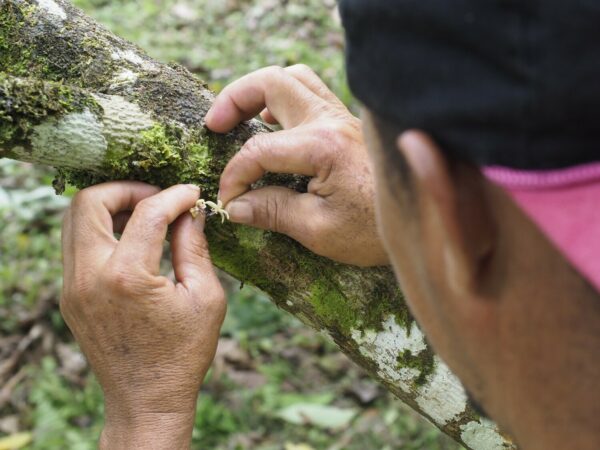Pollinators – such as bees, butterflies and birds – are essential for agricultural production. However, natural pollination can also fail or be insufficient, which can lead to lower yields and poorer quality. This means alternative solutions are needed. Hand pollination, in which pollen is applied manually or mechanically to the flower, can supplement or replace pollination by animals. Researchers from the Universities of Göttingen and Hohenheim now present the first systematic review of hand pollination of food crops. They show that hand pollination is used worldwide on 20 crops, including economically important plants such as apple, oil palm and cocoa. The results of the study were published in the journal Basic and Applied Ecology.
In recent years, the cultivation of crops that depend on pollinators has increased worldwide. At the same time, there has been a sharp and widespread decline in pollinators due to land-use changes, and in particular, more intensive agriculture. Little research has been done on where hand pollination is widespread and how significant it is. After reviewing the literature, the researchers found that hand pollination is frequently used for many fruits and, in fact, is used worldwide for vanilla, passion fruit, date palm, oil palm, and the two tree species, Atemoya (sugar apple) and Cherimoya (custard apple), whose fruits are important crops in the Americcan tropics.
There are many reasons – environmental, climatic or economic – why hand pollination might be necessary. The lack of natural pollinators is the most important driver, which can have various causes. In particular, crops that rely on a single, specialised species for pollination are at risk. Many plants are also cultivated outside their natural habitat, for example vanilla in Madagascar and oil palm in Indonesia. When the wild, natural pollinators of these crops are absent, hand pollination is often used. The overuse of pesticides and the loss of natural habitat for pollinators can also drive the need for hand pollination. For example, passion fruit production in Brazil is affected by low numbers of carpenter bees and Atemoya cultivation in Australia by missing sap beetles (Nitidulidae).
“Our study shows that hand pollination in agriculture can often reduce or prevent financial losses, which makes it an attractive and profitable method,” emphasises Professor Teja Tscharntke, Head of the Department of Agroecology at Göttingen University. Hand pollination allows farmers to ensure constant yields, avoid over- or under-pollination, manage the frequency of pollination, control the origin of the pollen and choose the optimal time for pollination. Indicators of quality – such as shape, size or juice content, which are crucial to ensure a high market value – can be improved for certain crops through hand pollination.
Professor Ingo Grass, Head of the Department of Ecology of Tropical Agricultural Systems at the University of Hohenheim, adds that hand pollination brings its own challenges and risks: “It is time-consuming and labour-intensive, as it involves several steps. These include harvesting, drying, storing, and distributing pollen. Investing in more labour and materials can be too expensive for large-scale farming systems in particular.” Thus, it is important to consider the costs and benefits of hand pollination before its introduction. Costs can be reduced by developing new technologies such as automated techniques, but if this is not possible, hand-pollination is often carried out by low-paid workers, even children, under poor working conditions. “Therefore, hand-pollination must be accompanied by socio-ecological standards that include the protection of natural pollinators and ways to ensure safe and fair work practices,” Grass concludes.
Annemarie Wurz, Agroecologist at the University of Göttingen and lead author of the study, emphasises: “Where natural pollination is available or can be restored, it has to be a priority, as it is the most efficient, cost-effective and biodiversity-friendly option.” The research team sees the potential of hand pollination where there are no pollinators – such as in vanilla cultivation in Madagascar – or where pollinators are not reliable enough – such as in passion fruit cultivation in Brazil.
Read the paper: Basic and Applied Ecology
Article source: University of Göttingen
Image: Hand pollination of cacao by Indonesian farmers in “Central Sulawesi, Indonesia”. Here, flowers are pressed on flowers to transfer pollen. Credit: Thomas C. Wanger






